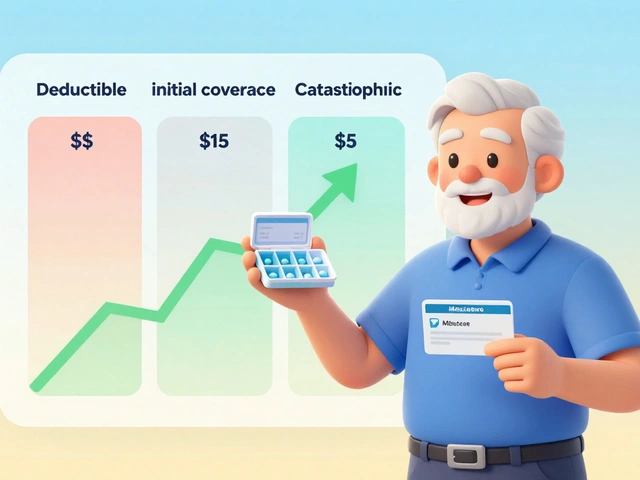Did you ever get that burning sensation in your chest after a big meal? Well, if you suffer from erosive esophagitis, you know it's not just a one-time thing. It can be a real pain, literally. But where does the keto diet fit into all this? Could going low-carb and high-fat be your ticket to relief?
You've probably heard a lot about keto lately—it's got people buzzing all over. But when you're dealing with erosive esophagitis, you've got to wonder: is it safe? Let's break it down and see if this diet trend aligns with those pesky esophageal limitations.
Keto is all about slashing carbs and loading up on fats, aiming to send your body into ketosis—a state where it burns fat for fuel instead of carbs. While that sounds straightforward enough, for folks with erosive esophagitis, the focus needs to shift slightly.
Balancing your diet to better manage symptoms is key. It’s not just about the food choices, but how your body reacts. Knowing what might trigger those uncomfortable episodes and finding a diet that respects these boundaries is crucial in adopting a new eating lifestyle like keto.
- Understanding Erosive Esophagitis
- Basics of the Keto Diet
- Keto's Impact on Esophageal Health
- Practical Tips for Symptom Management
Understanding Erosive Esophagitis
Alright, let's get to the root of erosive esophagitis. Picture this: your esophagus is a tube connecting your throat to your stomach, and it's lined with tissues that aren't too keen on mixing with stomach acid. When that acid flows back up—a condition known as acid reflux—it can cause the lining of your esophagus to become inflamed and sometimes develop tiny holes. That's what we call erosive esophagitis.
Why does this happen? Well, it often hinges on the lower esophageal sphincter, a muscle acting like a gatekeeper, making sure acid stays in the stomach. If this muscle relaxes too much or too often, acid sneaks up and wreaks havoc.
Common Symptoms
How do you know if you're dealing with erosive esophagitis? Look for these telltale signs:
- Persistent heartburn
- Difficulty swallowing (called dysphagia)
- Food feeling stuck in your throat
- Chest pain, especially after meals
- Nausea or regurgitation of food or sour liquid
Some folks brush off these symptoms as minor, but ignoring them can lead to bigger issues, like narrowing of the esophagus or even damage to its tissues.
Possible Causes
The big bad culprit might be a diet full of fatty or spicy foods, alcohol, or smoking—essentially, anything that relaxes that sphincter muscle too much. Being overweight, pregnant, or stressed can ramp up acid production, throwing fuel on the fire. Even some pesky medications that irritate the esophagus might play a part.
Diagnosis and Treatment
Getting tested usually involves an upper endoscopy, where docs take a peek inside with a tiny camera to assess the damage. Sometimes they also measure acid levels over a 24-hour period to get a clearer picture.
Treating erosive esophagitis generally starts with lifestyle changes. Avoid those trigger foods, quit smoking, and maybe even take up some gentle exercises. Medications like proton pump inhibitors (PPIs) or H2 blockers can also help by reducing stomach acid. But hey, every case is unique, so a healthcare professional's advice is crucial.
Now that you’ve got a grip on what erosive esophagitis entails, let's see how the keto diet fits into this puzzle and whether it might ease those symptoms.
Basics of the Keto Diet
The Keto Diet, short for ketogenic diet, sounds like a mouthful, right? But it's pretty straightforward. Picture this: you cut down on carbs and load up on healthy fats. So, instead of using sugar and carbs as your main energy source, your body switches to burning fat. This magical state is called ketosis.
How Does Keto Work?
Simple math! You reduce your daily intake to about 5-10% carbs, with fats making up around 70-75% of your diet. Proteins fill in the rest at about 20%. This shift forces your body into ketosis, meaning it taps into those fat reserves for energy. Sounds efficient, doesn't it?
Typical Keto Foods
Here's the fun part—stocking up on keto-friendly goodies!
- Fats: Think avocados, cheese, and nuts.
- Proteins: Meats and eggs are your friends.
- Veggies: Leafy greens like spinach and kale, plus a few cruciferous ones like broccoli.
It's not all rainbows and unicorns, though. Keeping your carb intake low means saying goodbye to certain comfort foods like bread, potatoes, and sweets. But the trade-off might be worth it for some.
Important Considerations
Trying keto requires some serious commitment. It's not just about eating a hunk of butter or an extra piece of bacon. You have to maintain a balanced diet to keep your body healthy, especially if you have digestive health concerns like erosive esophagitis.
A quick tip: if you're considering keto, it's wise to consult a nutritionist, especially for tailoring it to fit special conditions. Balancing keto with health conditions requires careful thought but can potentially offer some relief if done mindfully.
| Macronutrient | Percentage of Daily Intake |
|---|---|
| Fats | 70-75% |
| Proteins | 20% |
| Carbohydrates | 5-10% |
So, you see, keto isn't some wild, unstructured free-for-all. It's a disciplined approach with specific goals in mind, especially handy if you're looking to explore dietary changes for easing certain health conditions.

Keto's Impact on Esophageal Health
So what does the keto diet mean for someone dealing with erosive esophagitis? It's a mixed bag. Let's unpack some key points to better understand its potential pros and cons.
Fatty Foods: Friend or Foe?
On the keto diet, the focus is on high-fat intake. Now, fats can be a tricky area for those with digestive health issues. Some fats are more likely to trigger symptoms than others. Healthy fats from sources like avocados, nuts, and olive oil may be easier on the esophagus, while processed and fried foods could lead to trouble.
The Role of Low Carbs
Low-carb diets might actually offer some relief. When you drop carbs, you often cut out a lot of bread and pasta, which can sometimes irritate the esophagus. Also, reducing sugar intake can help minimize acid production, potentially easing symptoms.
Managing Triggers Wisely
One of the crucial things is identifying personal triggers. For some, certain high-fat foods may worsen symptoms. Keeping a food diary can help spot these triggers. Once identified, it's easier to make keto-friendly choices that don't compromise esophageal health.
Interestingly, a study found that following a low-carb diet reduced acid reflux symptoms in participants. This might mean good news for those with erosive esophagitis, suggesting that keto could be more helpful than harmful if managed correctly.
| Factor | Potential Impact |
|---|---|
| High Fat Intake | May trigger symptoms if unhealthy fats are consumed |
| Reduced Carbohydrates | Can help minimize acid production |
| Trigger Foods | Individual triggers vary, so personal monitoring is key |
The vital takeaway here? It's all about finding balance. The keto diet can be modified to align with the dietary needs of someone with erosive esophagitis, with an emphasis on healthier fats and careful monitoring of trigger foods.
Practical Tips for Symptom Management
When it comes to tackling erosive esophagitis on a keto diet, straightforward changes can make a world of difference. While the saber-rattling carb curtailment is the name of the keto game, how you manage this condition is just as important.
Monitor Your Fat Sources
Pay attention to where your fats come from. Opt for healthy fats like avocados, nuts, and olive oil. But hold back on excessive saturated fats, which might stir up trouble for your esophageal health.
Meal Timing and Portions
Eating smaller meals more frequently could prevent that full-stomach feeling that makes things worse. And maybe think about not eating too close to bedtime. Give your body time to properly digest before hitting the hay.
Stay Hydrated
Water can be your ally. Not only does it keep you hydrated, but it can also help aid digestion and reduce acidity. Going keto already ups your need for water, so it's a win-win.
Avoid Common Triggers
It’s no secret that foods like chocolate, caffeine, and spicy dishes can trigger flare-ups. They might ruin the fun of experimenting with new keto recipes, but steering clear could keep you comfy.
Keep a Food Journal
Knowing what works and what doesn't is half the battle. Jotting down what you eat and how it affects you can reveal patterns and help you make better choices.
Here's a simple reminder table to keep track of these aspects:
| Tip | Description |
|---|---|
| Healthy Fats | Choose avocados, nuts, olive oil |
| Meal Timing | Smaller meals, avoid late night eating |
| Stay Hydrated | Drink plenty of water daily |
| Avoid Triggers | Skip chocolate, caffeine, spicy foods |
| Food Journal | Track what you eat and your symptoms |
Tweaking your diet doesn't have to be overwhelming. Keep it simple and stick with these tips, and they just might help you find that comfortable balance between managing symptoms and enjoying your keto journey.




Javier Muniz on 20 March 2025, AT 20:48 PM
Hey everyone, if you’re juggling keto and erosive esophagitis, start by swapping out the heavy butter‑laden sauces for smoother options like avocado oil or plain Greek yogurt. Those choices keep the fat content up without the extra acid‑triggering spice. Also, split your meals into smaller bites throughout the day-this helps the LES stay closed and reduces reflux. Don’t forget to stay hydrated; water dilutes stomach acid and keeps the mucus lining happy. And most importantly, keep a simple food‑journal so you can spot any sneaky triggers early on.